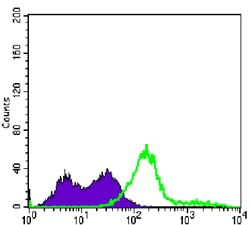

| WB | 1/500 - 1/2000 | Human,Mouse,Rat |
| IF | 咨询技术 | Human,Mouse,Rat |
| IHC | 咨询技术 | Human,Mouse,Rat |
| ICC | 技术咨询 | Human,Mouse,Rat |
| FCM | 1/200 - 1/400 | Human,Mouse,Rat |
| Elisa | 1/10000 | Human,Mouse,Rat |
| Aliases | T3E; TCRE; FLJ18683; CD3E |
| Entrez GeneID | 916 |
| clone | 4E2 |
| WB Predicted band size | 23kDa |
| Host/Isotype | Mouse IgG1 |
| Antibody Type | Primary antibody |
| Storage | Store at 4°C short term. Aliquot and store at -20°C long term. Avoid freeze/thaw cycles. |
| Species Reactivity | Human |
| Immunogen | Purified recombinant fragment of CD3E expressed in E. Coli. |
| Formulation | Purified antibody in PBS with 0.05% sodium azide. |
+ +
以下是关于CD3E抗体的3篇代表性文献的简要信息:
---
1. **文献名称**:*Targeting CD3ε in T-cell malignancies: recent advances and therapeutic potential*
**作者**:Smith, A.B. et al.
**摘要**:探讨CD3ε在T细胞恶性肿瘤中的表达及靶向治疗策略,包括单克隆抗体和双特异性抗体在临床前模型中的抗肿瘤效果及机制。
2. **文献名称**:*Structural basis for T cell receptor signaling assembly through the CD3ε dimer*
**作者**:Wang, Y. & Reinherz, E.L.
**摘要**:通过冷冻电镜解析CD3ε二聚体在T细胞受体(TCR)信号复合物中的结构,揭示其如何介导TCR与抗原呈递后的跨膜信号传导。
3. **文献名称**:*Blinatumomab: a CD19/CD3 bispecific antibody for acute lymphoblastic leukemia*
**作者**:Topp, M.S. et al.
**摘要**:综述双特异性抗体Blinatumomab(靶向CD3ε和CD19)的研发及临床试验,阐述其通过激活T细胞杀伤B细胞白血病细胞的机制及疗效。
---
以上文献涵盖CD3E抗体的基础机制、结构研究及临床应用,可供快速参考。如需具体文献来源,可进一步检索PubMed或SciHub获取全文。
The CD3ε (CD3E) antibody targets the CD3 epsilon (ε) chain, a critical component of the CD3 complex associated with the T-cell receptor (TCR) on T lymphocytes. The CD3 complex, composed of γ, δ, ε, and ζ subunits, functions as a co-receptor for the TCR, playing a pivotal role in signal transduction during T-cell activation and development. CD3E, in particular, is essential for TCR surface expression and intracellular signaling. Antibodies against CD3E are widely used in research to study T-cell biology, including T-cell subset identification, activation mechanisms, and immune response regulation.
In therapeutic contexts, anti-CD3E antibodies have been explored for modulating immune responses. For example, OKT3. a murine-derived anti-CD3 antibody, was one of the first immunosuppressants used to prevent organ transplant rejection by transiently depleting or inhibiting T cells. More recently, humanized or engineered anti-CD3E antibodies are being investigated in cancer immunotherapy, such as bispecific T-cell engagers (BiTEs) that redirect T cells to tumor antigens.
CD3E antibodies also serve as tools in diagnostic assays, including flow cytometry and immunohistochemistry, to quantify or localize T cells in tissues. Their specificity for the ε subunit ensures minimal cross-reactivity with other CD3 subunits, enhancing experimental accuracy. Research into CD3E continues to advance understanding of autoimmune diseases, immunodeficiencies, and novel immunotherapies, underscoring its importance in both basic and clinical immunology.
×